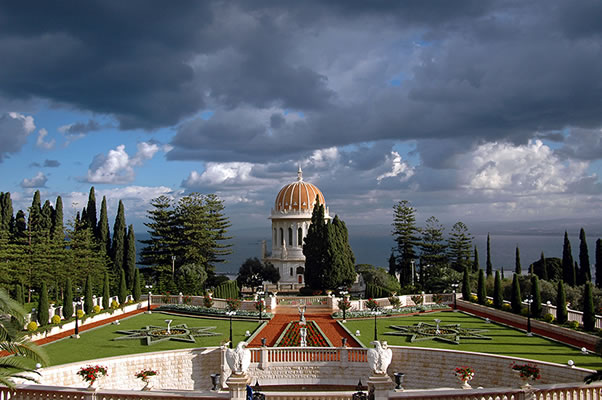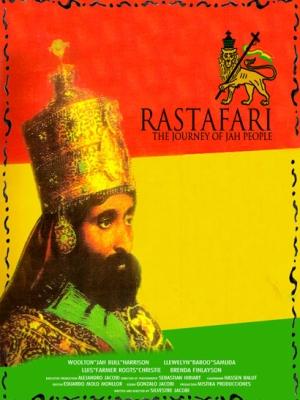As a college student at a Liberal Arts school, I am fortunate enough to be in a place that is a melting pot of lifestyles, cultures, and ideas. For the common folk, when one would think of the Rastafari, chances are, Bob Marley, dreadlocks and marijuana would come to mind. Although this is quite reasonable, as the stereotype is somewhat deserved due to societies uneducated portrayal of Rasta, there are so many more fascinating aspects that the Rastafari movement has to offer.
Within the Rastafari movement, there are three major branches. They are the Twelve Tribes of Isreal, the Niyabinghi , and the Bobo Shanti. For my Final Project, I will examine the Bobo Shanti branch of the Rastafari movement. Specifically, I will look at the symbols that exist within this branch, how they are perceived, and how they correlate with the life and beliefs of the Bobo Shanti.
The Bobo Shanti differ from the other branches because Religion is THE single most important aspect of their lives on a day to day basis, living in secluded community, they are able to live with extreme simplicity and purity which makes them a very special sect. While everyone has heard drudge reports on fundemantalist Christians, Muslims, and Jews, what I found fascinating is that the Bobo Shanti are the most fundemental/radical Rastafari group, however they exist harmoniously apart from society in a self sufficient manner.
Within the Rastafari movement, there are three major branches. They are the Twelve Tribes of Isreal, the Niyabinghi , and the Bobo Shanti. For my Final Project, I will examine the Bobo Shanti branch of the Rastafari movement. Specifically, I will look at the symbols that exist within this branch, how they are perceived, and how they correlate with the life and beliefs of the Bobo Shanti.
The Bobo Shanti differ from the other branches because Religion is THE single most important aspect of their lives on a day to day basis, living in secluded community, they are able to live with extreme simplicity and purity which makes them a very special sect. While everyone has heard drudge reports on fundemantalist Christians, Muslims, and Jews, what I found fascinating is that the Bobo Shanti are the most fundemental/radical Rastafari group, however they exist harmoniously apart from society in a self sufficient manner.
As opposed to just looking at what the Bobo Shanti believe, I will jump further into the continuation of this question, as to how their beliefs are versed through a system of symbols, and how this system incorporates into their respective lifestyle.
Clifford Gertz defines religion as
"A system of symbols which acts to establish powerful, pervasive and long lasting moods and motivations in men by formulating conceptions of a general order of existence and clothing these conceptions with such an aura of factuality that the moods and motivations seem uniquely realistic"
Bobo Shanti Symbols
While we have talked about the symbols within the Rastafari Movement, specifically the Bobo Shanti, I will touch on some that were not address as well as go further into a few we have touched on and examine their effects on the life of the Bobo Shanti people.
Although a part of the Rastafari, the Bobo Shanti symbols differ starting with their dress. Making them unique, they wear robes that reach down to their feet, and turbans on their heads. As opposed to wearing a turban for fashion like Rasta men do who are a part of the other branches, members of the Bobo Shanti wear the turban to supplement the dreadlocks which signifies their alignment with the Bobo Shanti sect. Also, notice the color of the turban is black. The the Bobo Shanti are the most radical sect of the Rastafari in their beliefs concerning black supremacy. While Black turbans are not entirely common, it is appropriate as the man in the picture is a high priest who has a large influence on his community and this re-iterates and further symbolizes black sovereignty and supremacy.
In addition, the Bobo Shanti women also where head dresses, once again not for style, but to simply pay respect to “Jah” . This also embodies the unique level of servitude that the Bobo Shanti possess and exemplify as it is not just a style as it may be in the other branches, but an action that speaks for the commitment and devotion of the Bobo Shanti.
A primary aspect of the Bobo Shanti society is the importance of community. The other branches of the Rastafari movement tend to be less organized and not as tight knit, however the Bobo Shanti exemplify their view on their value of community by their daily lifestyle. In this example, located atop a hill, the Bobo Shanti believe these grounds to be sacred, and only outsiders with special arrangements are allowed in the settlement. Living amongst one another in hand build huts, and apart from the rest of society, Bobo Shanti are independent of Jamaican rule they are basically self-sufficient. Supplementing this, they also live without running water and electricity, retainingthe basic Rastafarian symbol of simplicity.
Another aspect of Bobo Shanti life that has a huge influence on their daily life is the close accordance to “Old Testament Jewish Mosaic Law”[i]. As we watched in class, we saw how they had a specific schedule for prayer and fasting. Rising at specific hours of the day/night. By waking up at these times over the course of the day, the Bobo Shanti not only experience personal satisfaction and enhancement, but the overarching theme of simple discipline and commitment to oneself, the community, and Jah is demonstrated.

Standing outside a structure he constructed himself and providing a glimpse of his crops, a Bobo Shanti man exemplifies the Rastafari symbols of interconnectedness with the earth, simplicity, and care for nature. Also, as we discussed in class, his colors are the same as Ethiopian colors, symbolizing his devotion and desire to eventually return to Zion. Because they are self sufficient, they must grow crops and help produce not just for themselves, but the community as a whole
Certain Bobo Shanti settlements in Jamaica operate without any regard for actual Jamaican law. However, this does not mean that they run rampant. Because of their strict beliefs, and their close abiding to the ten commandments, The Bobo Shanti are able to go about their way of life in an un-regulated fashion(by the Government) because they do not need outside influence to enforce laws and principles upon them when they already practice a peaceful and productive way of life themselves. Paying strict attention to the Ten Commandments, the Bobo Shanti distinguish themselves from the other branches as they consciously and rigorously abide by them. Because they are somewhat un-regulated, this discipline arguably is why the Bobo Shanti can operate effectively while staying separate from the rest of Jamaican society.
Perhaps the most well known and frowned upon symbol of the Rastafarian Movement in general is the use of Marijuana. While the Bobo Shanti do smoke “herb” they do so privately as they view it as a sacred right that should only be performed during special periods of worship. Viewed as a spiritual rite, to help ease the mind and aid in prayer and reasoning, the Bobo Shanti use of Marijuana is significantly more contained than the other sects of the Rastafari movement. Once again, the re-occurring theme of discipline and abiding closely to set personal and religious boundaries is shown. Here, a preist shows his appreciation for herb, however unlike mainstream Rasta’s, he will only consume in a private personal setting.
Music is another symbol that is of great importance to the Rastafari. Who am I to do a report on the Rastafar without mentioning the legend himself, Bob Marley. In "War" Bob incorperates a speach by Haillie Salassie into the song while addressing racism and violence effected the Blacks in the region at the time. With the verse,"That until the basic human rights, Are equally guaranteed to all,Without regard to race, Dis a war" Bob adresses the massive amount of discrimination going on at the team and eventually looks to the future with the hope of peace and equality. This also ties in with the Bobo Shanti as many Bobo believe they deserve legal reparations for discrimination and slavery. As the most radical sect of the Rastafari, they advocate black rights and power very strongly, showing their pride for their roots and also their rejection of predjucice from caucasian Babylon.
The Lion of Judah represents former Emperor of Ethiopia Haile Selassie, who is believed by the Rastafari to be a god or "Jah" incarnate.
Conclusion
The Lion of Judah represents former Emperor of Ethiopia Haile Selassie, who is believed by the Rastafari to be a god or "Jah" incarnate.
Conclusion
Although a part of the Rastafarian Movement, the Bobo Shanti are a unique sect. Their commitment to purity, connection to the earth, and basic living principles separate them from the rest of the Rasta. In relative terms, they could be called radical as they interpret the Old Testament and the Ten Commandments literally, carrying out these ideals on a daily basis by the lifestyle that they live. Also, their commitment to one another and sense of community is a tremendous symbol in characterizing the sect as they are self-sufficient and somewhat un-regulated. This speaks for how effectively the Bobo Shanti society operates, and makes the sect distinguishable from the rest of the Rastafarian Movement.When I think of the Bobo Shanti, simplicity and purity come to mind. Like all religions, there are seperate branches, each interpreting and carrying out religious order with their own variations. In my opinion, out of all the groups we have studied, the Bobo Shanti remain the closest connected to their beliefs, and by being so connected with earth, one another, and Jah, their lifestyle naturally takes after these principles.
This trimester in class, we have examined how each religions system of symbols and how they play out into respective beleifs and lifestyles. From this, not only have we learned a great deal about each religion, more importantly we dug deeper into developing a better understanding of each of them by asking how and why along with continually examining historical and personal contexts. Overall, this has been an eye opening class for me, not because we studied a bunch of crazy religions, but because we examined how beliefs were developed which ultimately led to much better discussion and understanding of the topics, as opposed to just stopping at what they are in an objective sense.
This trimester in class, we have examined how each religions system of symbols and how they play out into respective beleifs and lifestyles. From this, not only have we learned a great deal about each religion, more importantly we dug deeper into developing a better understanding of each of them by asking how and why along with continually examining historical and personal contexts. Overall, this has been an eye opening class for me, not because we studied a bunch of crazy religions, but because we examined how beliefs were developed which ultimately led to much better discussion and understanding of the topics, as opposed to just stopping at what they are in an objective sense.





























